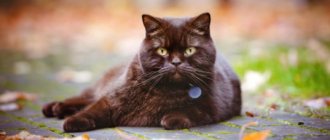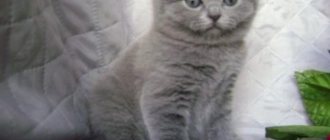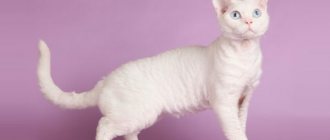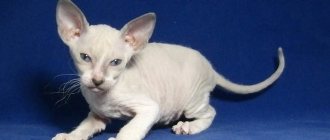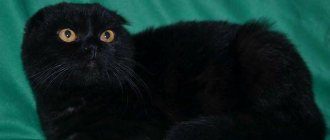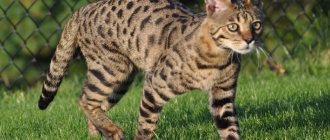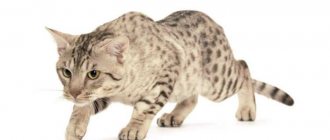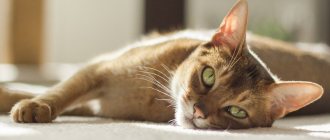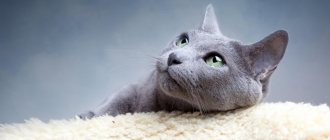Sokoke is a slender, muscular cat with long flexible legs and short fur, the contrasting pattern of which imitates the texture of tree rings. Its primitive beauty, combined with the independent disposition and grace of a wild predator, is highly appreciated by leading felinologists and becomes the subject of admiration for ordinary owners.
Let's figure out what's hidden behind the exotic appearance of a Sokoke cat.
Maintenance and care
Chartreux tolerates cold and humidity well. They can be kept in an apartment or country house. Due to their tendency to be overweight, cats need regular walks, so a pet living in an apartment should be walked outside every day. During walks, the cat must be put on a special leash. You need to walk in the morning or evening so that the cat does not get direct sunlight.
Your cat's fur needs to be brushed regularly. If you don't pay attention to the coat, over time, unsightly patches of matted fur will form on your pet's body. Also, removing dead hairs will protect the animal from the formation of hairballs in the stomach. During the molting period, brush the cat daily.
The frequency of water treatments depends on the cat’s participation in exhibitions. If the Chartreuse is a show pet, bathing is carried out 2 days before each exhibition. Regular pets are bathed as they become dirty. Since cats are very clean, the procedure is carried out no more than 1-2 times a year.
Bathing a pet has a number of features:
- the coat is very dense, so it doesn’t get wet easily;
- the abundant undercoat prevents shampoo from being washed out;
- Wool takes a long time to dry.
To bathe your pet you need to prepare 2 towels. One is placed at the bottom of the bath or shower, and the other is carefully wiped off the fur. Chartreux do not like to swim. However, during the procedure, as a rule, they behave calmly.
The cat's ears are cleaned 1-2 times a week or as they become dirty. For cleaning, use cotton swabs soaked in clean water. The eyes require daily care as this breed often has discharge from the eyes. Wipe off dirt with a damp soft cloth. An antiseptic can be used for the procedure once a week.
Nails are trimmed regularly with a nail clipper. If the owner does not have the skills to work with the tool, you should contact a veterinarian, since the nail plate is close to the blood vessels.
Kinkalow breeding issues
Dwarf cats with curled ears are rare and are still officially bred by several catteries - one in America and one in the UK.
Kinkalow breeding is very slow, which is why the breed remains rare
These dwarf purrs can be bred directly with representatives of their own breed, as well as with individuals of the original breeds - munchkins and American curls.
Before giving your pet for mating, you need to deworm the animal and get rid of parasites, if any (fleas, ear mites).
It is better to breed a kinkalow when the first estrus occurs, which occurs at the age of 1.5–2 years. This should not be done immediately, but only after two to three days.
A cat's pregnancy lasts about two months, and veterinarians advise giving birth to your pet no more than twice a year.
During the period of bearing kittens, the cat should be carefully looked after, enriching the diet with special vitamin and mineral complexes. The purr's sleeping place should always be warm and located in a secluded corner.
Maintenance and care
These exotic cats are very easy to care for, and they will not cause any trouble to the owner.
- The short hair of animals does not need frequent combing; it is enough to brush their thick coat once every one or two weeks.
- The Soukok cat loves to swim and can even jump into the bath herself to take water treatments.
- Ears and eyes are also easy to care for. Once every few days they are cleaned with a cotton swab or a cloth soaked in warm water.
- The Sokoke cat breed is distinguished by its mobility and energy, so the exotic pet will only be grateful to its owner if he takes it for a walk.
But do not forget that these animals are accustomed to the hot African climate. It is not recommended to walk them in winter, otherwise the pet may catch a cold.
Features of care
The cat requires careful and timely combing of its fur, cleaning of its ears and sharp teeth. It is necessary to clean the places where tears accumulate, and do not forget to bathe her once a month. Sokoke are very good about taking baths.
Cleaning the ears should also not cause difficulties: first, carefully remove all the outer lumps from the cat’s ears, and then, with careful movements, clean the ear canal using a swab, which must first be lubricated with mineral oil.
Along with monthly bathing, a person can organize daily washing for the cat. A clean rag is moistened with warm water, and then the nose, eyes are washed, and the entire muzzle is moistened with water. After squeezing the rag, you can remove unnecessary plaque from the corners of your eyes.
As for the brush that is used to comb the cat, it must be said that it should be made from natural materials, for example, from wild boar hair.
The advantages of a natural comb are obvious: firstly, it in no case leaves wounds on the skin; secondly, it helps to create good blood circulation in the cat’s body, and thirdly, it brings your pet’s fur to shine. Before brushing, you can rub the brush with a piece of chamois, then your cat will “shine” even more.
The cat needs to buy a special design against which it will do this without harm to itself or others. Today, a huge variety of them have been created for cats.
Keeping an Ocicat: necessary conditions, physical activity
A curious and restless pet must be provided with a sufficient number of toys, otherwise he will turn into them everything that comes to hand, or rather, paw, including valuables. To prevent your four-legged pet from damaging furniture and wallpaper, in addition to balls and wind-up mice, he should buy a gaming set. A smart Ocicat will also benefit from various puzzles. Representatives of this breed simply adore them.
To comfortably accommodate the tailed inhabitant of the home you will also need:
- bowls for food and water;
- scratching post;
- a tray with filler, which must be changed in a timely manner, otherwise the overly clean cat, sensing an unpleasant odor, will refuse to go into it.
Walking such a pet is not only possible, but also necessary. Representatives of this breed are not prone to running away, but if they see a dog nearby and panic, they may seek refuge in the trees. To avoid having to remove your pet from a high branch later, it is recommended to use a harness to walk it.
Walking principles
The room in which the cat is kept must be quite spacious, equipped with devices for jumping, climbing, and all kinds of labyrinths. When walking, it is better to use a harness or leash. Such animals quickly get used to the rules of behavior established by the owner, behave quietly on the street, exploring new objects and places. You should not have a Kenyan pet in country houses. Often being in nature, he begins to hunt in the natural environment and may leave the territory.
Cost of a Sokoke kitten
Despite the rarity of this breed, it can still be found if desired, but the cost of a representative of this breed is quite high.
The average cost of an animal reaches 60 thousand in rubles. You can find a kitten for 30 thousand. The price depends on gender and compliance with breed standards. There are options for 100 thousand. It also depends on the country in which the potential buyer is located. There are countries where there is not a single nursery with this breed, so many are willing to pay a lot of money just to get a valuable representative of the Sokoke.
Serengeti - description of the breed and character of the cat
How to choose the right Sokoke pet
Wanting to purchase a domesticated Kenyan cat, many connoisseurs of primitive beauty want to save money. It is worth knowing that purebred Sokoke are sold today only in breeding clubs or from serious breeders, so they certainly cannot be cheap. The average price for a kitten is approximately 60 thousand rubles. There are often cases when Sokoke are sold for 100 thousand rubles - you need to take into account that the breed is rare.
The final cost of the animal is influenced by three factors:
- pedigree;
- compliance;
- Country of Residence.
When choosing a Sokoke kitten, you should inquire in advance about the pedigree of the parents. The animal must be sold either with a passport or with a certificate, on the basis of which the new owner will independently create a passport.
A small kitten has weakly expressed signs of its breed, so it is very easy for an inexperienced novice breeder to fall for the tricks of scammers
It is important to know that kittens begin to be sold at the age of 13 weeks, when they are already completely independent. In kittens, the tip of the tail, the tips of the ears and the stripes on the paws should be slightly darker than the other patterns on the skin.
Regardless of color, the eye color should not be blue, otherwise it is not a purebred Sokoke.
Video: how Sokoke kittens play
https://youtube.com/watch?v=WKY8YL5mNkQ
The Sokoke breed was formed with minimal human intervention. That is why it is so valued among professional cat lovers. Unpretentiousness and good disposition make Sokoke excellent companions. The main quality of the breed is playfulness and love of water procedures.
Health
Cats are characterized by good health and immunity, but they also often get sick. Very often they suffer from nervous disorders that are inherited. During the mating season, when it comes to mating, the cat may convulse or run around the house in panic, not recognizing the owner. If this happens, then do not panic. You should try to calm your pet. If it doesn't work, call your veterinarian.
Many individuals are susceptible to meningitis. Meningitis is inflammation of areas of the brain and spinal cord. To maintain normal heart and blood vessels, taurine and vitamins of group E should be added to the diet. This will help maintain immunity. Animals can also be bothered by worms, painful sensations in the ears and plague. A possible source may be contact with individuals of a different breed; if problems arise, limit your social circle.
When choosing a kitten, you should pay attention to its parents, or rather, their behavior
History of origin
Today there are more than a dozen young breeds, and the Soukok also belongs to this category. The story of the rise began in 1977, when a family of forest cats (several cubs and their mother) was discovered on a plantation (the territory of the modern Arabuko Sokoke National African Park of Kenya) of a certain Englishwoman Janie Slater.
The woman liked the luxurious marble design and appearance of the foundlings so much that she could not resist and adopted a couple of kittens, and later began breeding them. Surprisingly, the little savages quickly got used to the house, as if they had always lived next to a person.
In any case, when Danish cat lover Gloria Moldrup visited Janie Slater, she immediately purchased a cute pair of wild cats and took them to her homeland.
Almost instantly, the unusual forest beauties gained popularity among cat breeders in Denmark. As a result, their numbers quickly increased, especially since Gloria repeatedly returned to Kenya to bring new “blood” for the development of the breed.
In 1993, the breed was first recognized by FIFe (international felinological organization). Later, the breed was registered in TICA, as well as in the cat federations of Canada and Great Britain.
In Europe, soukok are not so popular, and there are few of them in Russia. The main population of cats is found in Denmark and, of course, Africa in their natural habitat.
Relatively recently, the British Jenny Hammer, who lives in Kenya, managed to discover a variety of soukok. It is somewhat different from the already known blue eye color and color: there are silver inclusions on the fur coat. These "snow" cats were classified as a new line and in 2008, TICA assigned it a provisional standard.
Character
Sokoke is an exotic breed of cat whose pedigree contains blood from both wild animals and domestic cats. Her ancestors are considered to be kittens found by Englishwoman Janie Slater in Kenya. The woman liked them so much that after a while, together with her Danish friend Gloria Moldrup, she decided to start breeding this unusual breed. Sokoke was officially registered with the FIFe in 1993.
The cat of this breed resembles a miniature cheetah: large ears, tabby color and restless character - everything speaks of wild relatives. By the way, it’s interesting that absolutely all Sokoke, regardless of color intensity, have a necklace around their neck; this is their distinctive feature. Moreover, it can be either closed or intermittent.
African Shorthair cats are known for their activity, curiosity and irrepressible energy; they cannot sit still, and therefore all kinds of games, teasers, and multi-tiered houses will give them pleasure.
Sokoke are quite independent, but they cannot live without their beloved owner, they become attached to him very quickly and for life. Therefore, a cat of this breed is unlikely to be suitable for people who spend a lot of time at work or traveling.
Sokoke are very sociable, and meeting unfamiliar guests does not frighten them, as does meeting animals, including dogs. These cats quickly find a common language with their relatives.
Sokoke are ready to play with children all day long. Who, if not a child, can support a cat in fun races and hide and seek?
Characteristics
Despite its small size, it is not recommended to keep soukok in a small apartment. This is a very active and playful breed. Kenyan foresties love to run, jump on high surfaces and play with everything that comes their way. In a small and cramped room, such a cat will feel constrained and uncomfortable.
Sokoke is an affectionate and gentle animal. Having such a pet, you can be sure that you will bathe in your love and affection. In addition, this breed is ideally suited for a family with children. Soukok will be happy to frolic with them all day long. After all, all she wants is for someone to run and jump with her.
Sokoke cats are playful. They are characterized by activity, intelligence and intelligence. But the savagery of their descendants gave them willfulness and independence. It is impossible not to note their ability to become attached to their owners. They also have established communication with anyone who comes to visit and with some animals (cats of different breeds and dogs). An affectionate and calm character pacifies all family members (but due to a hereditary disease, cats have problems with the nervous system).
Sokoke cat breed photo
The peculiarity of “cheetah” cats is that, like trained animals, they can tirelessly jump, run, swim, and skillfully jump from one tree to the next. Such skills are already in the Sokoke’s blood; there is no need to teach them; the abilities were probably handed down by their ancestors.
Although cats of this breed adapt to apartments, it is, of course, advisable to keep an exotic cat in a house with a large yard. After all, in the yard you can make a play corner with an imitation of a forest, perhaps install artificial trees, as well as sand and toys for cats. Energy and a cheerful disposition need to go somewhere, but you should still fence the yard area with a fence to prevent escape. In this case, cats will not look for a place to play in rooms and will not damage furniture and objects in the house.
The hunting instinct does not affect relationships with the outside world, but it is important to remember that poor nutrition can cause aggression. The advantage of cats is that they do not require much attention and can easily tolerate solitude while their owners are at work.
But it is important to prepare everything for the pastime, given that Sokoke love a lot of free space. At the end of the day, you can see how the pet missed its owner, happily greeting him.
This breed does not have the habit of meowing disgustingly and asking for something, or lying near its owners. Their energy lasts for the whole day. During walks, Sokoke cats can accompany their owners. Fearlessness and masculinity help cats survive in unexpected situations.
Cats are careful with children, do not show aggression, and love to play. It happens that they are frightened by the screams and pranks of children.
Sokoke inherited tirelessness, playfulness and love of freedom from their wild ancestors. Peace-loving cats immediately endear themselves to absolutely all family members.
Families with children will appreciate the playfulness of the breed. Mustachioed friends are happy to support children's activity. However, they are not at all aggressive. Even when they get into a rage, they don’t let go of their claws. The good nature also extends to other pets.
They easily share territory with both cats and dogs.
Despite their affection, forest cats always find something to do alone. Therefore, to avoid incidents, it is better to provide your pet with a variety of toys in advance.
African cats are real talkers. They can conduct a cat monologue for hours, telling all their joys and experiences. Fortunately for owners, animals have a loud, but pleasant voice.
The ideal habitat would be a private house with limited areas and planted trees. An apartment would be fine too. But for a comfortable stay for your pet, it is best to arrange a play corner there. By providing the animal with climbing structures.
Interesting Facts
During the existence of the breed, many interesting things have been associated with it:
- Sokoke have several alternative names. These cats are also known as Kenyan Forest and Soukok cats.
- A special study was conducted to establish the natural origin of sokoke. As a result, it was found out that they have a common DNA structure with the spotted street cats of Eastern Kenya and the cats of Lamu Island. Based on this, the Kenyan Forest was included in a separate racial group called the Arabian Sea.
- In ancient times, when cattle were considered a luxury item, Kenyan aborigines consumed sokoke as food.
- Due to the spiral wood pattern on their brown fur, forest cats were called "kanzonzo", which means "bark-like".
Description of the breed
An exception has been made for this cat: the species of tree cats has been known in Africa for a long time, they have a common name - hadzonzo (“peeping out of the crown”), and this population lives only in the territory of a small region of Kenya - Sokoke and are insectivores. These “peeking out from the crown”, of course, can catch a bird or destroy its nest, they can also kill a small rodent if they come across one, but they prefer to hunt caterpillars and beetles, deftly opening the bark of trees with their long thin claws, and getting to those hiding there larvae. This is a hairy woodpecker-orderly without wings, but with four limbs.
These cats also prefer to live and breed in trees; they do not like to walk on the ground at all, and over many centuries of such a life, even their legs have undergone some changes. The hind legs stretched out and their bones took on the shape of a sickle, moving the hock joints far upward, which, of course, gives an advantage when moving through trees, but hinders when moving on flat surfaces, in particular on the ground.
On the ground, the cat seems inactive and even a little clumsy, because it has to squat all the time, otherwise its butt would be higher than its head and the cat would poke its nose into the ground when walking. Sokoke do not know how to move by jumping like a rabbit, and move like a kangaroo - in a column, until they learn how. So Kenya parva cattus has to walk holding her butt, but we must give her credit - this does not in any way affect the speed of movements and dexterity of insectivorous cats.
In addition, such paws allow you to swim perfectly, using the length of your hind legs instead of flippers, and this cat loves to swim! Plus, in the water you can have a hearty lunch with tadpoles, small fish or water beetles. Very useful long legs for such a small predator!
The Hadzonzo, in turn, did not disturb human settlements with their ruinous raids. This is how African tribes and African tree cats lived in peace and harmony for many centuries.
Everything changed when the Sokoke cat and her litter ended up in the home of British citizen Jenny Slater.
History of the breed
Appearance
A distinctive feature of Sokoke is their characteristic striped color. The color of the stripes can vary from warm light brown to dark chestnut, and the eyes can range from greenish to yellow. The variety called “snow sokoke” has a cream or grayish-beige tabby tabby color and blue eyes.
Sokoke has a flexible, slender and graceful body of medium length, with a developed rounded chest and a straight back. A small wedge-shaped head, the top line of which appears almost level in profile. The cheekbones are high and clearly defined. Ear size is medium to moderately large. The eyes are quite large, widely spaced, slightly almond-shaped and inclined towards the base of the ears.
The legs are slender and long, with medium to thin bones. The paws are oval and small in size, which gives the impression that the cat is constantly walking on tiptoe.
In general, sokoke may look thin and even fragile, but once you hold them in your hands, you can feel the strength and dexterity in these beautiful creatures.
Temperament
Despite their wild past, representatives of the breed live very well under the same roof with humans. They love to climb onto cabinets and bookshelves, decorating the most inaccessible places in the house. If there is nothing to break or knock over on these raised areas, this habit will not cause problems. Sokoke, of course, is not the kind of pet that will desperately seek people’s attention and purr on its owner’s lap for long evenings. But such a cat shows its affection for its owner by following everywhere around the house and “talking” to him. Breeders note that some representatives of the breed may even be too “talkative.”
Sokoke usually get along well with all family members and other pets. At the same time, they are always on the alert and will not allow themselves to be offended. If a cat feels threatened by children or other pets and cannot escape in time, it will not hesitate to use its teeth and claws.
Standards
The appearance of the Siberian cat is impressive: its body is powerful, large, covered with thick and long hair. Females weigh 4-5 kg, the weight of an adult cat is much larger - 7-8 kg, and sometimes reaches up to 12! These are real long-livers - sometimes they live up to 20 years.
| Standard | Description |
| Head | Trapezoidal, with smooth lines. There is no clearly defined “stop”. The chin is clearly defined, as are the cheekbones, and the cheeks are round and full. |
| Ears | Wide at the bottom, triangular, with rounded tips. They are slightly inclined forward, pubescent both outside and inside. |
| Eyes | Oval, very expressive. Small, but open. Placed slightly obliquely, widely. Iris color: yellow or green (all shades). |
| Torso | Massive, with a wide back and a strong rear. The chest is voluminous, the neck is muscular and short. The paws are thick, of medium length, with well-developed muscles. The paws are round and wide, flattened. The fur grows in tufts between the toes. |
| Tail | Long and shaggy, tapering towards the tip. |
| Wool | The coat is very dense. The undercoat is very soft and delicate to the touch (due to the fact that the texture of the hairs is thin). The top layer of wool is stiffer, grows evenly, and in the area of the sides and tail seems to “fall” down. Siberian wool repels moisture well. By winter, the “fur coat” becomes thicker and shinier, especially in the area of the “collar” and “panties” on the hind legs. |
Significant disadvantages of the breed:
- “Bare” fingers;
- Coat growing in tufts and dull, lack of undercoat;
- Tail with bald spots, short or too long;
- Eyes that are too big or small;
- Ears too small or large;
- Flat cheeks, elongated muzzle, long thin neck, poorly developed bones.
Catering
Sokoke can be fed both natural and ready-made food. But it’s better to make a choice as soon as the baby comes into your home, and in the future the diet should be changed only if absolutely necessary. The cat's stomach, having become accustomed to one type of food, may react painfully to such changes.
The cat's menu should be balanced: contain sufficient amounts of fats, carbohydrates, proteins, as well as minerals and vitamins.
Natural food requires standing at the stove every day and running around shops and markets, but you will know for sure that the food is fresh and pamper your pet with one dish or another.
Natural products
- Sources of protein: meat (veal, chicken, beef, turkey, lamb), offal (liver, kidneys, ventricles, hearts), fish (salmon, flounder, trout, navaga), chicken and quail eggs, dairy products (ryazhenka, kefir , cottage cheese, yogurt).
- Sources of fats: vegetable oils (olive, sunflower, flaxseed), chicken yolk, fish oil, offal.
- Sources of carbohydrates: porridge (rice, oatmeal, buckwheat, corn, wheat), boiled or raw vegetables (pumpkin, carrots, green beans, asparagus, broccoli, zucchini, cauliflower).
The amount of food depends on the age, condition of the breed and the general physical condition of the animal. Cats older than one year are fed 2 times a day: morning and evening. Adolescents from 6 months to six months - 3 times. Under 6 months - 4-6 times.
Recommended food
When choosing ready-made food, carefully read the reviews of the owners, the recommendations of veterinarians and the labels on the packages. Don’t believe advertising slogans and bright pictures: there is not much quality food available. First of all, these include food from the holistic group. These foods are made from high-quality products; they contain plenty of meat, vegetables and healthy additives, and there are no harmful components at all. But holistic foods are also expensive.
Super-premium foods are a step below holistic foods, and they are somewhat lower in quality. Firstly, the percentage of meat is not indicated, and secondly, corn and wheat are sometimes used (which can cause allergies).
Premium and economy food are even worse. Wheat and corn are used there all the time; instead of meat, remnants of the human food industry are added (this can be leather or ground bones).
Holistic food: Applaws, Carnilove, Orijen, Power of Nature. Super premium food: Brit Care, Summit, Vet Life.
| Holistic | Super premium | Super premium |
| Wellnes | Duke's Farm | Dr Clauder's |
In addition to simple food, the cat must be given a good vitamin and mineral supplement, as well as sprouting grass to cleanse the stomach of hair. This is not a blessing, but a necessity: wool forms lumps in the stomach, which causes discomfort and a direct path to diseases of the gastrointestinal tract. Fresh grass helps get rid of them.
Interesting Facts
The friendliness and peaceful nature of Sokoke cats is dictated by the fact that this breed was developed by hybrid crossing wild forest cats and feral domestic cats. Despite their exotic and even wild appearance, cats are perfectly adapted to living in city apartments with humans.
Interesting video about the breed:
Kenyans call these cats "kanzonzo" - literally translated as "bark-like". This name stems from the times when African cats were hunted for their edibility. It was difficult for the Aborigines to get a cat as prey, because... their spiral pattern on their brown fur resembled that of tree bark and provided amazing camouflage in jungle environments.
Work on breeding Sokoke in Europe began because a friend of the “discoverer” of the breed took one of the kittens to a cat show in Denmark, where it was immediately recognized as a miniature cheetah. The exotic appearance captivated the Europeans, and since then work began to standardize the breed.
Ear treatment
Short-haired African representatives are distinguished by large ears that require special care. Approximately 1-2 times a week, it is necessary to remove surface dirt from them with a cotton swab dipped in water. If this procedure is not enough, pharmaceutical oils are used as an additional care product. Any liquid used should not get deep into the ear. After the procedure is completed, it is unacceptable for the pet to remain in a draft or cold.
Historical information about the breed
Representatives of the cat soukok received this name because of the area of the same name, located in Kenya. Their ancestors are the forest cats of Africa; it is not surprising that such animals for a long period were known only among local aborigines. Reliable sources indicate that the official beginning of the breed dates back to 1978, when Janie Slater, the owner of a coconut plantation, discovered wild kittens with an unusual color and took them in for upbringing. Later, the animals that reached sexual maturity were bred. The offspring of four-legged pets were exported to Italy and Denmark. It is from these countries that the Soukok bloodlines originate.
Already in the 2000s, new blood appeared in the breed from other Kenyan cats that continued the breed. Their descendants spread to America and European countries. After several years, scientists worked on genetic research and determined that representatives of the Soukok are nothing more than a cross between an Arabian wild cat and an Asian domestic cat.
Currently, the rare and unusual breed belongs to the Arabian Sea racial group. The reason for this is their similarity in DNA analysis with the spotted animals of Kenya, living on the street, and cats from the island of Lamu.
In the 70s of the last century, an Englishwoman, Jenny, discovered kittens with cheetah-like coloring in the Sokoke forest in Kenya. The breed began to be named after the forest where it was discovered - Sokoke. It was this woman from England who became the person who first started breeding them.
Ten years later, Jenny's friend began distributing these cats in Denmark. At first it was called the African Shorthair. But in 1992, the Danish government officially approved the name “Sokoke” for the breed.
At the same time, in the homeland of the Sokoke, in Kenya, various hybrids began to be bred on various private farms, up to the appearance of snow-colored cats.
The feline offspring of the breed in Kenya began to be called kazonzo, due to the fact that the color of the cat was similar to the bark of trees. They quickly jumped through the trees in search of food: small birds, rodents. Sokoke adopted many character traits from their predecessors.
Breed card
| Characteristics of a cat | Notes | |
| General information | The cats are descended from Kenyan tabbies. | One of the few breeds of African origin |
| Character | Friendly, calm cats, affectionate towards family members | |
| Appearance | Typical tabby, with markings on the sides reminiscent of wood fibers | Agouti ticking may appear on the tail |
| Behavior at home | Gets along well at home, prefers dark places | Kittens are attached to their mother cat for a long time |
| Care | Cats should be brushed with a comb and a brush with natural bristles to keep their fur looking beautiful and shiny. | Lack of undercoat makes grooming easier |
| Health problems | Afraid of the cold and susceptible to various infections | Get your vaccinations on schedule |
Origin story
Jenny Slater, an Englishwoman, owner of a small coconut plantation at the foot of the Kenya volcano, was incredibly surprised when one sunny morning in 1978. I discovered a “nest” of an insectivorous tree cat with a whole litter of tabby kittens near my house.
Jenny took pity on the exhausted, weakened animal and accepted the family into her home. The cat mother did not show any aggression when moving the children to a new place of residence; rather, on the contrary, she accepted the help with gratitude, she was so exhausted and weak.
This is how the first Sokoke got the opportunity to survive and “register” in a human home.
The striped Hadzonzos grew quickly and became stronger, fed on nutritious mother's milk, and Jenny Slater monitored the richness of this milk, providing the mother cat with a rich diet. The cat, in turn, acted as if it had been born and raised in Jenn's house.
Jenny even thought that it was someone’s already tamed cat, but there was no owner and Jenny had to take care of the Sokoke family on her own.
To Jenny, the behavior of the “savage” seemed strange, to put it mildly. Therefore, she gave 2 of her pet’s kittens to her friend Gloria Moldrup, who took them to Denmark in 1985.
Gloria Moldrup quickly appreciated the benefits of the expertise and invited her friend Jenn to establish a nursery for breeding a “wild-wild” breed of cats that are so easy to contact with humans.
So in 1988 On the territory of Mount Kenya, a nursery for keeping and breeding aboriginal cats of the Sokoke breed appeared. The “founders,” of course, were the kittens that took root in Jenny’s house.
One day in the 1970s, an English woman found cheetah-colored kittens in a Kenyan forest. Therefore, the breed is also called forest - Sokoke. The Englishwoman's name was Janie S., who founded this hybrid breed.
After 10 years, her friend decided to transport exotic cats to Denmark, and after 3 years the cats were named African Shorthairs. Nine years later (1992), the Danish state recognized and approved the Sokoke cat breed. In 1978, hybrid cats began to appear on a Kenyan farm by crossing wild cats with domestic ones. Interestingly, some breeders have started breeding snow-colored Sokoke.
The name has been updated by the International Cat Breeding Organization (FIFE), so they are also called soukok, but more often sokoke. The main thing is that they are still considered rare (there are about 100 of them left).
The basis of the Sokoke breed was made up of African cats living in Kenya, in the Soukok region. In 1978, Janie Slater, who lived there, discovered exotic-looking kittens on a coconut plantation - she brought two of them home (they became the founders of the breed, which Slater called “African Shorthair”).
Sokoke were first presented at an exhibition in Copenhagen in 1984, then in Odense... In 1992, the new breed was recognized by Danish felinologists, and a year later by the European Federation of Cat Fanciers.
We suggest you read: Why does a cat lick a person’s hands?
DNA research of the newly-minted breed took place within the framework of the Cat Genome Project - the genes of Arabian wild and Asian domestic cats were found in the blood of Sokoke. Hybrid heredity is fully confirmed by the habits of Sokoke: unlike their truly wild relatives, they are easily tamed and quickly come into contact with people and other cats.
Today, these pets can most often be found in Kenya, Denmark and the USA.
Characteristics of the Sokoke breed
Standard
Today, the standards for the Sokoke breed are the following:
- Body: medium size, slender, with long graceful legs. The muscles are strong. The hind legs are slightly longer than the front legs, making the cat appear to “squat” when walking. The tail is moderately long, with a rounded tip. The weight of Sokoke cats reaches 3 kg, males - up to 5 kg.
- Head: The head shape of representatives of the breed is wedge-shaped, the neck is short and muscular.
- Eyes: almond-shaped, large, slightly slanted. Eye color is amber, sometimes interspersed with green.
- Coat: short, smooth. The color resembles a marbled tabby. Black stripes in the form of a spiral and half rings are clearly visible on the fur. The main color of the Sokoke coat is brown, available in various shades.
- Color: There are two variants of Sokoke coat color: standard and snow tabby.
The standard color is characterized by a basic warm bronze shade of the coat, which turns into pale tones on the lower part of the body. The brown coat has contrasting black and brown markings. On the paws, closer to the pads, the fur has a dark shade - the color of the pads.
The Snow Tabby has a distinct pattern all over its body, similar to the classic Tabby. The main color of the coat in this color is much lighter than in the standard color - almost ivory. The paw pads and nose of cats of this color are pink. The eye color differs from the standard one - with the snow tabby color, the eyes should be light blue, without any green or amber impurities.
Health
The lifespan of a cat is 15 years. Sokoke is in good health. Due to the low prevalence of this breed, there is no reliable information about the characteristic diseases of these cats. It should be noted that cats of this breed have large ears, which should be regularly cleaned and examined to prevent infectious diseases.
In addition, given that the Sokoke is a breed from the African continent, these pets should be protected from hypothermia - they love warmth and catch colds easily.
There have been cases where, during the mating period, cats became uncontrollable, overexcited, and experienced bouts of increased activity, even convulsions. This is not typical for all representatives of the breed, but is a hereditary feature of one of the parental lines.
Character
Sokoke cats are people oriented. They are friendly, very playful and peaceful. Cats get along easily with other pets and become attached to family members. Sokoke are suitable for families with children - they love to spend time with people, do not let out their claws, and allow themselves to be petted. However, if threatened, the animal may show aggression, bite or scratch the offender.
Sokoke love to play - by themselves, with their owner, and with other animals. Cats can occupy their time on their own, but prefer to be near a person when possible. They follow the person they choose, caress, jump on their knees and position themselves next to the owner’s workplace in order to always be closer to him.
Cats meow often. They can demand food, affection using their voice, or simply “talk” to the owner in their own language. This breed's voice is not annoying, but quite loud.
Sokoke are highly intelligent animals. They are easy to train, get used to the tray, scratching post, and learn the rules of behavior in the house. The cats themselves are quite clean - they take care of their fur, regularly sharpen their claws, and clean themselves of dirt.
Possible problems
It is not recommended to have an African Shorthair cat for people who are not used to active animals and prefer a calm, lazy creature as a pet.
In addition, residents of the northern regions should pay attention to the heating of the room in which the pet will live - otherwise, the cat will catch a cold and get sick. Sokoke should not be left in a poorly heated, damp room with drafts, because
The only weakness of this breed is low temperatures.
Possible problems
An African shorthair cat as a pet is not suitable for a person who is not accustomed to active and funny animals. Moreover, people living in cold northern regions should pay special attention to the microclimate of the room in which the soukok settles. If this point is overlooked, the domesticated forest dweller will often get sick and catch colds. It is unacceptable for such cats to stay in insufficiently heated, damp rooms with noticeable drafts, since their only weakness is the low ambient temperature.
